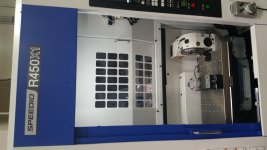Can't attached pictures in PM's, so I'm just going to reply here.
Here's the base of it all: All double disc ground, doweled to the table and to the risers. I bought a long ER16 holder specifically to reach the vise risers so I could dust them off. Between both pallets, I ended up taking .0015" off at the worst to get them all perfect (not shown).

That setup with two Orange 17.5" doubles weighs roughly 330 pounds, so I believe four vises no matter the configuration, will go over the max 400 pound-per-pallet rating. But there's a setting to limit the pallet rotation speed when you go over that weight. And really, this thing is so fucking fast man, you probably won't ever notice the time difference. I mean, if it doubles the pallet change time, that's about 7 seconds total. If you do 100 cycles per day that's just shy of 6 minutes lost. If four vises gain you 10 minutes over two vises, there you go.
However, if the only reason you want four vises on each pallet is to get more parts on the table at a time, this thing is so fucking fast that I urge you to consider two vises instead. I'll give you an example why: Most of my programs use local sub routines. The Brother control, although I like it very much, is pretty much 180º to the Haas control in the way it functions, and there's a lot of program structure that needs to be changed. So the first job we ran ended up doing this every time I changed work offsets:
- Home the Z
- Stop spindle from 16k, coolant off
- Position X and Y
- Start spindle to 16k, coolant on
- Rapid to clearance plane
That process happened 12 unnecessary times in that program. Being the anal moron I am, I had to get rid of those extra moves. So again, picture that entire process happening 12 times, seems like a lot of time wasted, right? When fixed, the program ran a whopping 9 seconds faster. It doesn't even make sense... .75 seconds for all that? That's what the timers said.
Got off topic there. So yeah, the Z is weird. It gets even more weird when you do a G100 tool change to your fancy spindle probe (you did get probing, right???) and watch the pallet bulkhead wiz by the probe tip at mach 8.2. I haven't had to worry about it, but over a certain tool length I'm sure you can't use G100 tool change anymore if that tool is the first to run. Otherwise the bulkhead will hit the tool as the pallet is rotating in.
EDIT: The one thing that really caught me off gaurd is the clearances on these vises. All I thought about was keeping everything inside the max fixture area I think they call it. Well, when you are using a double vise and only using the near station, the screw gets pushed out and can get REALLY close to a bunch of shit, to include the loading station door (which I've already ripped off the machine once), the non-moving bulkhead (which we've already busted up) and the Y axis way cover inside the machining area. To solve these issues once and for all, I made a vise cradle with contact switches which is wired to the machine. If either of the wrench vises are not in their home, the machine alarms when it tries to rotate the pallet. Yamazen was a massive help with this. And I'm going to put a window in the enclosure, to the right of the control so you can see the pallet rotate from all sides during a setup.
And one last thing, don't hesitate to ask dumb questions of Yamazen, now or after the install. If they put up with the shit I asked of them, then they will put up with anything.





